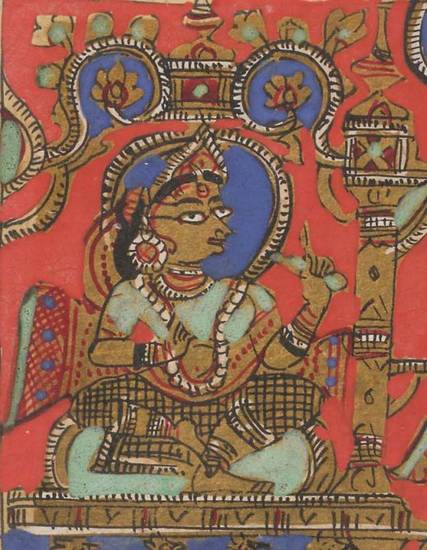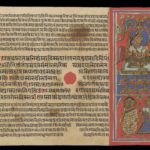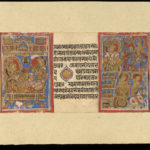Article: Rājīmatī
Rājīmatī, also known as Rājul in medieval and contemporary contexts, is one of the 16 satīs, or soḷ satī, and included in every satī list. Rājīmatī’s story is the most widely told satī narrative probably because of its pivotal significance in the tale of the renunciation of the 22nd Jina, Neminātha or Lord Nemi. As with the tales of other sol satī, Rājīmatī’s story contains examples of renunciation, faithfulness, modesty, chastity and religious devotion that are believed to be especially powerful for women. It therefore provides a model of female virtues.
The earliest version of Rājīmatī’s tale dates back to the Uttarādhyayana-sūtra and has been a very popular subject for Jain narratives, poetry and hymns to the present day.
The early accounts of Rājīmatī’s story celebrate compassion and renunciation while denigrating the body, particularly the female body. Later versions shift the focus of the story to centre on her love for Nemi. In these, Rājīmatī’s story becomes more clearly linked to rituals associated with happy marriages while also serving as a model for female renunciation.
Story of Rājīmatī
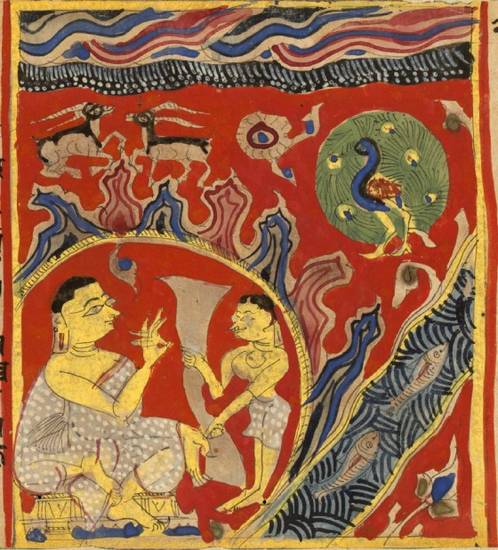
Rājīmatī and Rathanemi in the cave
Image by Victoria and Albert Museum © V&A Images/Victoria and Albert Museum, London
Rājīmatī’s tale was originally found within the narrative of the life of the 22nd Jina, Neminātha or Lord Nemi. The different Jain sects largely agree upon core incidents of the story but the Śvetāmbara and Digambara sects differ on the course of events after Nemi leaves his bride. The tale has probably been adapted partly to support conflicting views on the religious position of women in the two sects.
Prince Nemi had wanted to become an ascetic from an early age. After much cajoling, however, the Jina-to-be Nemi was engaged to Princess Rājīmatī, the daughter of King Ugrasen. When Nemi’s wedding procession arrived at Rājīmatī’s home on the day of their wedding, her mother blessed him at the threshold of the door.
But when Nemi heard the crying of the animals that were to be killed for the wedding feast he felt deep compassion for them and disgust for the world. He decided to renounce the life of the householder at once. He turned around and left his bride standing at the threshold of her house.
Rājīmatī lamented her fate but, when it was clear that Nemi would not be returning, she decided to follow Nemi to Girnār and renounce with him.
In Śvetāmbara versions, after announcing her intention to renounce, Rājīmatī travels to Mount Girnār to join Nemi. On the mountain she is caught in the rain and ducks into a cave to dry off. She removes her clothing to let it dry. The monk Rathanemi, who is also Nemi’s elder brother, sees her. He approaches Rājīmatī begging her to have an affair with him and then become a nun after they have enjoyed all the worldly pleasures of this rare human birth. Rājīmatī does not accept Rathanemi’s proposal but instead gives him a sermon about the vileness of her own body, comparing herself to vomit. Rathanemi remembers his vows and is transformed into an ideal monk. Rājīmatī renounces the world and becomes a nun.
Finally, according to Śvetāmbara versions Rājīmatī and Nemi achieved liberation at their deaths on the same day and were, in a sense, reunited.
In Digambara versions, Rājīmatī does not become a nun but is still recognised as a satī. Likewise, she and Nemi die on the same day and Nemi achieves omniscience and liberation while Rājīmatī is born again as a male god in heaven.
References in Jain writings
Rājīmatī’s story appears as early as the Uttarādhyayana-sūtra, which dates back hundreds of years, and has been retold many times in medieval and modern Jain tales, poems and hymns. Over the centuries the focus of the tale has changed. It is still a significant story of inspirational renunciation but has also become strongly associated with love, fidelity and marriage. As with the tales of the other 16 satīs – soḷ satī – the themes are believed to be particularly important for women.
The Uttarādhyayana-sūtra contains the earliest surviving version of the story of Nemi and Rājīmatī. In this version, the underlying themes are:
- celebration of compassion
- glorification of renunciation
- vilification of the body, especially the female body.
This telling is the key source for the basic story. Later versions of the Rājīmatī story by monks are clearly influenced by this early and authoritative account.
Love, fidelity and marriage in poetry
By the medieval period, Rājīmatī’s love for Neminātha or Lord Nemi becomes central to the story, linking the Jain and Hindu genres of love poetry. In medieval phāgus – four-month rainy-season poems – and bārahmāsa – twelve-month poems – Rājīmatī waits four months or twelve months for Nemi to return before resigning herself to renunciation.
The oldest known phāgus and viraha bārahmāsās – four and twelve-month poems of separation – are Jain works dedicated to the story of Nemi and Rājīmatī. One of the two oldest phāgus, Rājaśekhara-sūri’s 14th-century Neminātha-phāgu was dedicated to Rājīmatī’s laments after her rejection. The oldest bārahmāsā is Dharma-sūri’s 13th-century Bārah navaū and the oldest viraha bārahmāsa is Vinayacandra-sūri’s 14th-century Rājal Bārahmāsā.
Most of these Jain bārahmāsā poems retell the story of Nemi’s renunciation on his wedding day and the suffering of his jilted fiancée. The phāgu and bārahmāsā poetic forms describe each month in turn, linking the natural environment and seasons with the emotions of the protagonist. Bārahmāsā poems sometimes describe the religious or agricultural year or form a narrative epic lasting a year, but Jain versions focus instead on the suffering of the separated lover and the trials of chastity. In these medieval tellings the Rathanemi episode is not the central scene. Instead, Rājīmatī’s renunciation is presented as the perfect example of not abandoning love. Rathanemi gives up the world of marriage yet stays true to her husband, although in a different way from traditional notions of marital faithfulness.
The most significant later telling is Devcand’s 18th-century text, Nemanāth Saloko. This text is recited publicly at temple celebrations on the day of Nemi and Rājīmatī’s unfinished wedding and that of Nemi’s renunciation.
The story of Nemi and Rājīmatī has been the subject of a multitude of hymns including sajjhāys and stavans. In particular, the genre of veil songs – cunḍaḍī gīt – is almost exclusively dedicated to the story of Rājīmatī. These hymns are performed in temples dedicated to Nemi and on days associated with Nemi’s life but these hymns are also part of the standard repertoire of devotional hymns known to devout Jains. The veil songs are popular at night-singing sessions, especially those led by Marwari Jains, whether or not there is any connection between the performance and Nemi.
In more recent times, many versions of the story have been told in novels and comic books and on audio recordings, such as audio cassettes.
Related rituals
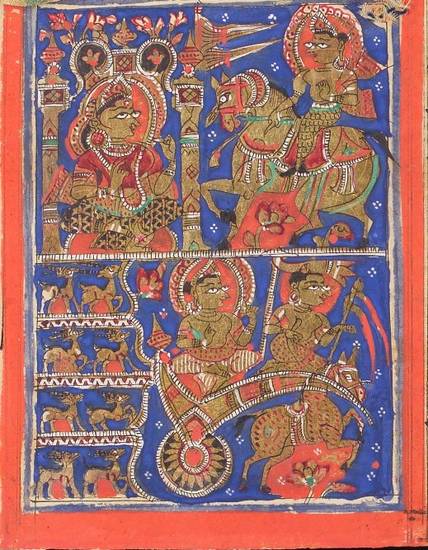
Nemi’s renunciation
Image by Wellcome Trust Library © Wellcome Library, London
The story of Nemi and Rājīmatī has strong associations with renunciation and marriage, clearly brought out in rituals performed each year and frequently at weddings. At first glance the two concepts of renunciation and marriage might seem to be direct opposites, but they can be thought of as complementary states for Jains within the notion of the fourfold community.
Devcand’s 18th-century text, Nemanāth Saloko, is recited annually on Śrāvaṇ bright fifth, the day on which Nemi and Rājīmatī were to be married and on which Nemi renounced the world.
The annual recitation is linked to the Saubhāgya Pañcami Tap – ‘Auspiciousness Fifth Fast’ – which blesses a woman with a long and healthy marriage. Nemanāth Saloko has also been recited at weddings, as this act is widely believed to bless marriages.
Reading
- ‘The Jain Sacred Cosmos: Selections from a Medieval Pilgrimage Text’
John E. Cort - The Clever Adulteress and Other Stories: A Treasury of Jain Literature
edited by Phyllis Granoff
Mosaic Press; Oakville, Ontario, Canada; New York, USA; London, UK; 1993
- ‘The Meat at the Wedding Feast: Kṛṣṇa, Vegetarianism and a Jain Dispute’
Paul Dundas - Jain Doctrine and Practice: Academic Perspectives
edited by Joseph T. O’Connell
volume 13
Centre for South Asian Studies of the University of Toronto; Toronto, Canada; 2000
- Gender and Chastity: Female Jain Renouncers
Sherry Fohr - PhD dissertation submitted to University of Virginia in 2001
- Heroic Wives: Rituals, Stories and the Virtues of Jain Wifehood
M. Whitney Kelting - Oxford University Press USA; New York, USA; 2009
- Honour, Nurture and Festivity: Aspects of Female Religiosity amongst Jain Women in Jaipur
Josephine Reynell - PhD dissertation submitted to University of Cambridge in 1985
- The Unknown Pilgrims: The voice of the sādhvīs – the history, spirituality, and life of the Jaina women ascetics
N. Shāntā - translated by Mary Rogers
Sri Garib Dass Oriental series; volume 219
Sri Satguru Publications; New Delhi, India; 1997
- 'Rājal-Bārahmāsā'
Vinayacandra-sūri - Bārahmāsā in Indian Literatures: Songs of the twelve months in Indo-Aryan literatures
edited by Charlotte Vaudeville
Motilal Banarsidass; New Delhi, India; 1986
- ‘Ahimsa and Compassion in Jainism’
Kristi L. Wiley - Studies in Jaina History and Culture: Disputes and Dialogues
edited by Peter Flügel
Routledge Advances in Jaina Studies series; volume 1
Routledge Curzon Press; London, UK; 2006
Links
- Nemi decides to renounce
-
This illustrated page from a 15th-century manuscript of the Kalpa-sūtra is provided by the National Gallery of Australia. At the beginning of the section dealing with the 22nd Jina, Ariṣṭanemi, also called Nemi, the painting shows the famous episode of Prince Nemi's decision to renounce worldly life just before his wedding. He is so appalled by the distress of the animals due to be killed for his wedding feast that he decides to become a monk.
http://artsearch.nga.gov.au/Detail-LRG.cfm?View=LRG&IRN=147981&PICTAUS=TRUE
- Views of the temples at Mount Girnar
-
Collection of photographs of the temples found at Mount Girnar. The 22nd Jina, Neminātha or Lord Nemi, is closely associated with Mount Girnar, having renounced the world, gained omniscience and then final liberation here. There are 16 Jain temples on the site, which is sacred to both Jains and Hindus. These photographs are presented by Professor Frances W. Pritchett of Columbia University in New York.
http://www.columbia.edu/itc/mealac/pritchett/00routesdata/1000_1099/jaintemples/girnar/girnar.html
- A Jina renounces
-
This highly decorated page from a 15th-century manuscript of the Kalpa-sūtra is provided by the National Gallery of Australia. A young man performs the rite of keśa-loca – ‘pulling out of the hair’ – which indicates indifference to the body. It is part of the initiation ceremony of dīkṣā, in which an initiate renounces the world and becomes a mendicant. He is watched by Śakra, king of the gods who takes an active role in the lives of the 24 Jinas.
http://artsearch.nga.gov.au/Detail-LRG.cfm?IRN=177852&View=LRG
- Five Great Monastic Vows
-
Pravin K. Shah writes about the Five Great Vows taken by Jain monks and nuns. The information is provided by the Jainism Literature Center, associated with the Faculty of Arts and Sciences at Harvard University.
http://www.fas.harvard.edu/~pluralsm/affiliates/jainism/jainedu/5greatvows.htm
- A Śvetāmbara nun descends from Shatrunjaya
-
A nun from a Śvetāmbara Mūrtipūjaka mendicant order runs barefoot down the steps leading down from Mount Shatrunjaya. This temple-city in Gujarat is one of the most significant Śvetāmbara Mūrtipūjaka pilgrimage sites. The steep path from the foot to the summit, where the principal shrines are found, has around 4000 steps.
- Two Śvetāmbara Terāpanthin samaṇī nuns
-
This YouTube video dating from 2009 shows two Śvetāmbara Terāpanthin samaṇīs tallking about their religious background and beliefs. They hold folded cloths in front of their mouths while they speak. Normally Śvetāmbara Terāpanthin monks and nuns wear a mouthcloth – muṃhpatti – permanently over their mouths, hanging from strings over the ears. Samaṇīs have important roles in teaching the Jain diaspora.
- Terāpanthin monks and nuns
-
This YouTube video shows Śvetāmbara Terāpanthin monks and nuns walking down a street in New Delhi in July 2009. Clad in white and wearing the mouth cloth – muṃhpatti – they walk barefoot, carrying their monastic equipment in bags and bundles. They are accompanied by lay Jains, many of the women dressed in orange, which is a holy colour in India. Among the monks is Ācārya Mahāprajña, the tenth ācārya or leader of the sect, who died in May 2010.
- +
- aAbhavya
- aAbhinandana
- aAbhiṣeka
- aĀcāra
- aĀcārāṅga-sūtra
- aĀcārya
- aAchalbhrata
- aAḍhāī-dvīpa
- aAdharma
- aAdho-loka
- aAdhyayana
- aAdvaita Vedānta
- aĀgama
- aAghātīya
- aAghātīya-karman
- aAgnibhuti
- aAgra
- aĀhāra
- aAhiṃsā
- aAhimsa Day
- aAjita
- aAjīva
- aAkampit
- aĀkāśa
- aAkbar the Great
- aAkṣaya-tṛtīyā
- aAlauddin Khalji
- aAlbert Einstein
- aAllah
- aAlms
- aĀlocanā
- aAloka-ākāśa
- aAmāri
- aAmbikā or Kūṣmāṇḍinī
- aAnagāra
- aAnanta
- aAnarthadaṇḍa
- aAnaśana
- aAnekānta-vāda
- aAṅga
- aAniconism
- aAnojjā
- aAntarāla
- aAntarāya-karma
- aAṇu
- aAṇu-vrata
- aAnukampā
- aAnuprekṣā
- aAnusvāra
- aApabhraṃśa
- aAparigraha
- aAra
- aĀrambha
- aĀrambhaja
- aĀratī
- aArdhamāgadhī Prākrit
- aArhaṃ
- aArhat
- aArśana-āvaraṇīya-karma
- aĀrta-dhyāna
- aĀryikā
- aĀryikā Jñānamati
- aĀśātanā
- aĀścarya
- aAscetic
- aAsceticism
- aAshram
- aAspiration
- aĀsrava
- aAṣṭa-maṅgala
- aAṣṭāpada
- aAstikāya
- aAstrolabe
- aAsura
- aAtheism
- aAticāra
- aAtiśayakṣetra
- aAtithisaṃvibhāgavrata
- aĀtma-vāda
- aĀtman
- aAuṃ
- aAurangzeb
- aAuspicious
- aAusterity
- aAvadhāna
- aAvadhi-jñāna
- aĀvaraṇī-yakarman
- aAvasarpiṇī
- aAvatāra
- aAvidyā
- aAxiom
- aĀyāga-paṭa
- aĀyambil
- aĀyu-karma
- aĀyurveda
- bBabur
- bBāhubali
- bBaladeva
- bBālāvabodha
- bBandha
- bBasadi
- bBazaar
- bBhadrankarvijay
- bBhagavant
- bBhaktāmara-stotra
- bBhakti
- bBhale
- bBharata
- bBhāṣā
- bBhāṣya
- bBhaṭṭāraka
- bBhāva
- bBhāva-pūjā
- bBhāvanā
- bBhavana-vāsin
- bBhavya
- bBhavyatva
- bBhaya
- bBhoga-bhūmi
- bBhogopabhoga
- bBodhi
- bBollywood
- bBrahmā
- bBrahma-deva
- bBrahmacārī
- bBrāhmaṇa
- bBraj Bhāṣā
- bBright fortnight
- bBritish Raj
- bBuddha
- bBuddhi-sagar
- bBuddhism
- bBuddhist
- cCaitya
- cCaityavāsin
- cCakravartin
- cCakreśvarī
- cCāmara
- cCandanā
- cCandragupta
- cCandraprabha
- cCanon
- cCāritra
- cCāritramohanīya-karman
- cCarũrī
- cCaste
- cCaturvidha-saṅgha
- cCaturviṃśati-stava
- cCāturyāma
- cCE
- cCelibacy
- cCha
- cChadmastha
- cChastity
- cCheda-sūtra
- cChristian
- cChristianity
- cClergy
- cCloning
- cColophon
- cCommentary
- cConch
- cConfession
- cCongregation
- cConsecration
- cCosmology
- cCremation
- cCrore
- cCult
- cCūrṇi
- dDādā-guru
- dDalit
- dDāna
- dDaṇḍa
- dDark fortnight
- dDarśana
- dDarśanamohanī-yakarman
- dDaśa-lakṣaṇa-parvan
- dDeity
- dDelhi Sultanate
- dDerāsar
- dDeśāvakāśika-vrata
- dDetachment
- dDevanāgarī
- dDevānandā
- dDevarddhi-gani
- dDevotee
- dDhamal
- dDhanuṣ
- dDhāra
- dDharma
- dDharma-dhyāna
- dDharma-sāgara
- dDharmastikaya
- dDhātakīkhaṇḍa
- dDholak
- dDhyāna
- dDiaspora
- dDig-vrata
- dDigambara
- dDīkṣā
- dDisciple
- dDīvālī
- dDivya-dhvani
- dDNA
- dDoctrine
- dDogma
- dDonor
- dDoṣa
- dDravya
- dDravya-pūjā
- dDrone
- dDuṣamā
- dDuṣamā-duṣamā
- dDuṣamā-suṣamā
- dDveṣa
- dDvīpa
- eEast India Company
- eEightfold Path
- eEkānta-vāda
- eEkendriya
- eElder
- eElders
- eEschatology
- eEtc up to
- fFarmān
- fFast
- fFatehpur Sikri
- fFestival
- fFestschrift
- fFiruz Shah
- fFly-Whisks
- fFolio
- fFour Noble Truths
- gGaccha
- gGaṇa
- gGaṇadhara
- gGanadharavada
- gGaṇeśa
- gGaṇin
- gGarba
- gGarbha
- gGarbha-gṛha
- gGaruḍa
- gGati
- gGene
- gGenomics
- gGhātī-yakarman
- gGhātīya
- gGhaznavid
- gGhiyasuddin Tughlaq
- gGhurid
- gGloss
- gGotra-karma
- gGujarāt
- gGujarati
- gGuṇa
- gGuṇa-sthāna
- gGuṇa-vrata
- gGupti
- gGuru
- gGuruṇī
- hHagiography
- hHajj
- hHaṃsa
- hHaribhadra
- hHariṇaigameṣin
- hHasta
- hHeresy
- hHiṃsā
- hHindi
- hHindu
- hHinduism
- hHīravijaya
- hHoroscope
- hHrīṃ
- hHumayun
- hHymn
- iIconoclasm
- iIconography
- iIdol
- iIndian Independence
- iIndology
- iIndra
- iIndrabhūti Gautama
- iIndriya
- iInitiation
- iIntercession
- iInvocation
- iIQ
- iIslam
- iIslamicate
- iIṣṭadevatā
- iĪśvara
- jJagat
- jJahangir
- jJain
- jJaina Devanāgarī
- jJaina Śaurasenī
- jJaina-dharma
- jJainaśāsana
- jJainness
- jJaisalmer
- jJamāli
- jJambū-dvīpa
- jJames Burgess
- jJanma
- jJanma-kalyāṇa
- jJarā
- jJāti
- jJina
- jJina-āgama
- jJina-bhavana
- jJina-bimba
- jJina-mātā
- jJinacandra-sūri
- jJinadatta
- jJinaprabha
- jJīva
- jJñāna
- jJñāna-āvaraṇīya-karma
- jJñāna-āvarṇiya
- jJñānsundar
- jJyotiṣka
- kKāla
- kKālakācārya-kathā
- kKālidāsa
- kKalpa-sūtra
- kKalpa-vṛkṣa
- kKalyāṇaka
- kKalyanvijay
- kKamaṇḍalu
- kKamaṭha
- kKarma
- kKarma-bhūmi
- kKarma-grantha
- kKarma-prakṛti
- kKarma-vāda
- kKarmon
- kKarnataka
- kKaṣāya
- kKathā
- kKāvya
- kKāya
- kKāyotsarga
- kKeśa-loca
- kKetu
- kKevala-jñāna
- kKevalin
- kKhalji
- kKharatara-gaccha
- kKnowledge
- kKriyā
- kKriyā-vāda
- kKṛṣṇa
- kKṣamā-śramaṇa
- kKṣapakaśreṇi
- kKṣatriya
- kKṣullaka
- kKulakara
- kKundakunda
- kKunthu
- lLabdhi
- lLaity
- lLakh
- lLāñchana
- lLands of Action
- lLaukāntika
- lLavaṇa-samudra
- lLeśyā
- lLiṅga
- lLinguistics
- lLoka
- lLoka-ākāśa
- lLoka-puruṣa
- lLoka-vāda
- lLotus
- lLotus lake
- mMadhya-loka
- mMahā-videha
- mMahā-vrata
- mMahābhārata
- mMahāmastakābhiṣeka
- mMāhārāṣṭra
- mMāhārāṣṭrī Prākrit
- mMahattarā Yākinī
- mMahāvīr Jayantī
- mMahāvīra
- mMakāra
- mMakkhali Gośāla
- mMalli
- mMāna-stambha
- mManaḥ-paryāya-jñāna
- mMaṇḍala
- mMaṇḍapa
- mMandit
- mMaṅgala
- mMantra
- mMantras
- mManuṣya-loka
- mMarāṭhī
- mMārgaṇā
- mMartyr
- mMarudevī
- mMaṭha
- mMati-jñāna
- mMauryaputra
- mMecca
- mMendicant lineage
- mMetarya
- mMiracle
- mMithyādṛṣṭi
- mMohandas Gandhi
- mMohanīya-karma
- mMokṣa
- mMonastic order
- mMonasticism
- mMonk
- mMonotheism
- mMosque
- mMount Meru
- mMount Sammeta
- mMṛgāvatī
- mMughal
- mMuhammad
- mMuhammad bin Tughlaq
- mMuhpattī
- mMūla-sūtra
- mMūlaguṇa
- mMumbaī
- mMuni
- mMunisuvrata
- mMurad Bakhsh
- mMūrti-pūjaka
- mMuslim
- mMysticism
- nNābhi
- nNāga-kal
- nNāgapurīya Tapā-gaccha
- nNāgarī
- nNāma-karma
- nNamaskāra-mantra
- nNami
- nNandīśvara-dvīpa
- nNandivardhana
- nNandyāvarta
- nNāraka
- nNāraki
- nNasalisation
- nNātha
- nNavrātrī
- nNaya-vāda
- nNemi
- nNidāna
- nniggaṃthāṇa vā 2
- nniggaṃtho vā 2
- nNigoda
- nNihnava
- nNikṣepa
- nNirgrantha
- nNirjarā
- nNirvāṇa
- nNiryukti
- nNiṣidhi
- nNitya
- nNiyati
- nNo-kaṣāya
- nNudity
- nNun
- oOcean of milk
- oOmniscience
- oOrdination
- ppa°
- pPadmaprabha
- pPadmāsana
- pPadmāvatī
- pPādukā
- pPalanquin
- pPalette
- pPañca-muṣṭi
- pPāṇḍava
- pPaṇḍit
- pPandit Dalsukh D. Malvania
- pPandit Sukhlalji
- pPāṇipātra
- pPāpa
- pParamātman
- pParameṣṭhin
- pPāraṇā
- pParigraha
- pPariṇāma
- pParīṣaha
- pParokṣa
- pPārśva
- pPārśvanātha
- pParyāya
- pParyuṣaṇ
- pPaṭa
- pPatan
- pPātra
- pPenance
- pPersian
- pPhala
- pPhilology
- pPicchikā
- pPilgrimage
- pPīr
- pPolymath
- pPoṣadha
- pPossession
- pPothī
- pPrabhas
- pPradakṣiṇā
- pPradeśa
- pPrākāra
- pPrakīrṇaka-sūtra
- pPrākrit
- pPramāda
- pPramukhā
- pPrati-vāsudeva
- pPratikramaṇa
- pPratimā
- pPratiṣṭhā
- pPratyākhyāna
- pPratyakṣa
- pPravacana
- pPrāyaścitta
- pPrayer
- pPre-modern
- pPreach
- pPredestination
- pProtestant
- pProvenance
- pPudgala
- pPūjā
- pPujārī
- pPukharavara-dvīpa
- pPuṇya
- pPūrva
- pPuṣkara-dvīpa
- pPuṣpadanta
- pPyre
- qQur’an
- rRāga
- rRāhu
- rRainy season
- rRajasthan
- rRajasthani
- rRājimatī
- rRajoharaṇa
- rRajput
- rRāma
- rRāmāyaṇa
- rRangoli
- rRās-garbā
- rRasa
- rRathanemi
- rRatna-traya
- rRātri-bhojana
- rRaudra-dhyāna
- rRecto
- rRelic
- rRenunciation
- rRetroflex
- rRevatī
- %Ṛg-veda
- rRite
- rRosary
- %Ṛṣabha
- %Ṛṣabhanātha
- rRupee
- sSaciyā Mātā
- sSādhu
- sSādhvī
- sSāgāra
- sSaint
- sŚaivaism
- sŚaka-saṃvat
- sSallekhanā
- sŚalya
- sSamacatuṣṭha
- sSamādhimaraṇa
- sSamaṇi
- sSāmarambha
- sSamavasaraṇa
- sSāmāyika
- sSaṃbhava
- sSamiti
- sSaṃjñā
- sSaṃkalpaja
- sSaṃsāra
- sSamudghāta
- sSaṃvara
- sSaṃvega
- sSamyak-cāritra
- sSamyak-darśana
- sSamyak-jñāna
- sSamyaktva
- sSaṃyama
- sSanctuary
- sSandalwood
- sSaṇgha
- sSanskrit
- sSant
- sŚānti
- sSapta-bhaṅgi-naya
- sSārambha
- sSarasvatī
- sSarvajña
- sSāsan-devi
- sŚāsana-devatā
- sŚāstra
- %Ṣaṭ-jīvanikāya
- sSatī
- sSatīmātā
- sSatya
- sSchism
- sScribe
- sScripture
- sSect
- sSecularism
- sŚenāī
- sSermon
- sŚeṣavatī
- sSevā
- sSeven fields of donation
- sShah Jahan
- sShantidas Jhaveri
- sShrine
- sSiddha
- sSiddha-śilā
- sSiddhacakra or Navadevatā
- sSiddhānta
- sSiddhārtha
- sSiddhi
- sSikh
- sSikhism
- sŚikṣā-vrata
- sŚīla
- sSin
- sSindh
- sŚītala
- sŚiva
- sSkandha
- sSomanatha
- sŚraddhā
- sŚramaṇa
- sŚrāvaka
- sŚrāvakācāra
- sŚrāvikā
- sŚreyāṃsa
- sŚrī
- sŚrīvatsa
- sŚruta-jñāna
- sŚruta-pañcamī
- sSthānaka-vāsin
- sSthāpanācārya
- sSthāvara
- sSthavira
- sSthiti
- sStrīmukti
- sStūpa
- sSubcontinent
- sSudarshana
- sŚuddhi
- sSudharma
- sŚūdra
- sSufism
- sSukha
- sŚukla-dhyāna
- sSulasā
- sSultan
- sSumati
- sSundarśrī
- sSupārśva
- sSūri
- sSuṣamā
- sSuṣamā-duṣamā
- sSuṣamā-suṣamā
- sSūtra
- sSuyam me ausam! Tenam bhagavaya evamakkhayam
- sSvādhyāya
- sSvāhā
- sSvastika
- sŚvetāmbara
- sŚvetāmbara Terāpanthin
- sŚvetāmbaras
- sSwan
- sSyād-vāda
- tTabla
- tTantra
- tTapā-gaccha
- tTapas
- tTāraṇ Svāmī Panth
- tTattva
- tTattvārtha-sūtra
- tTemple
- tTemple-city
- tThe Enlightenment
- tTheology
- tThree worlds
- %Ṭīkā
- tTilaka
- tTīrtha
- tTīrthaṃkaranāma-karman
- tTīrthankara
- tTransliteration
- tTrasa
- tTrasa-nāḍī
- tTriśalā
- tTriṣaṣṭi-śalākā-puruṣa-caritra
- tTti bemi
- tTughlaq
- tTunk
- uUdumbara
- uUniversal History
- uUpādhyāya
- uUpāṅga
- uUpaniṣads
- uUpāsaka
- uUpasarga
- uUpāśraya
- uŪrdhva-loka
- uUtsarpiṇī
- uUttarādhyayana-sūtra
- vVāhana
- vVaimānika
- vVairāgya
- vVaiṣṇava
- vVaiśramaṇa
- vVaiśya
- vValabhī
- vVanaspatikāya
- vVandana
- vVaṇik
- vVarṇa
- vVāsudeva
- vVāsupūjya
- vVayubhūti
- vVeda
- vVedanīya-karma
- vVegetarianism
- vVehicle
- vVernacular
- vVerso
- vVidyā
- vVidyā-devī
- vVihāra
- vVijñapti-patra
- vVikrama-saṃvat
- vVikṛti
- vVimala
- vVinaya
- vVipāka
- vVirji Vora
- vVirodhaja
- vVīrya
- vVisarga
- vViṣṇu
- vVītarāga
- vVizier
- vVotive
- vVow
- vVrata
- vVS
- vVyakta
- vVyantara
- vVyasana
- yYakṣa
- yYakṣī
- yYantra
- yYaśoda
- yYaśovijaya
- yYati
- yYātrā
- yYoga
- yYoginī
- yYojana


